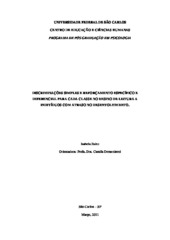Discriminações simples e reforçamento específico e diferencial para cada classe no ensino de leitura a indivíduos com atraso no desenvolvimento
Abstract
Training procedures in researchs about the estabilishment of stimulus equivalence classes are tipically based on conditional discriminations, in wich a sample controls selection of a comparison stimulus. Proposals based on simple discrimination have been suggested in order to expand the potential of such technology and empirical model. Considering also that reinforcers are a part of stimulus equivalence class, the use of specific reinforcers to each class may assist in the emergence of equivalent stimuli classes. The preset study aimed to propose a training structure combining simple and conditional discrimination and differential and specific reinforcement for each stimulus class to teach reading of six simple isolated words from to individuals with developmental delay. Participants were 14 individuals with developmental delay enrolled in a special education institution with ages ranging from nine to 15 years. They were divided in two groups and randomly assigned to an experimental or control group. LECH-GEIC software was utilized for programming and effectuation of the teaching program, which training consisted on four phases: 1. simple discrimination between pictures 2. simple discrimination between printed words, 3. conditional discrimination between pictures with onomatopoeic auditory model. 4 conditional discrimination between printed words with onomatopoeic auditory model. Results pointed that there was a higher number of repetitions and errors in the conditional discriminations condition. There was evidence of formation of stimuli equivalence classes for all or some classes of stimuli for all participants in the experimental group. The average percentage of correct selections on symmetry and transitivity tests evaluated by BC and CB matching performances was substantially higher in post-test (CB = 81.3%, BC = 72%) compared to pre-test (CB = 45.8 % BC = 40.4%), and this difference was statistically significant (Wilcoxon Z =- 2.197, p <0.028 (BC) Z =- 2.366, p <0.018 (CB)). Reading of the training words for this group increased from a correct average percentage of 2.3% at pre-test to 53.57% at post-test (Wilcoxon Z =- 2.371, p <0.018). There were no statistical significant differences in performance between control and experimental groups at pre-tests (Mann-Whitney U), however, the experimental group, at post-tests, scored significantly higher in comparison to the control group at AC (U = 1 , 0, p <0.001), BC (U = 2.0, p <0.002), CB (U = 6, p <0.017), CC (U = 10.0, p <0.043), CRCCs (U = 8 , 0, p <0.038) relations and naming of training words (U = 0.5, p <0.001). Neither group presented generalized reading. By starting from a simple discrimination training prior to conditional discrimination, the procedure has created a situation of complexity teaching from simple to more elaborate repertories. The use of specific reinforcers may have assisted the emergence of untrained repertoires, such as AC, BC, CB relations and reading. The performance on equivalence tests and reading of some stimuli may have been hampered by multiple similarities between some written words and absence of auditory model in training phases, since onomatopoeic sounds were used as models in situations of conditional discriminations.
